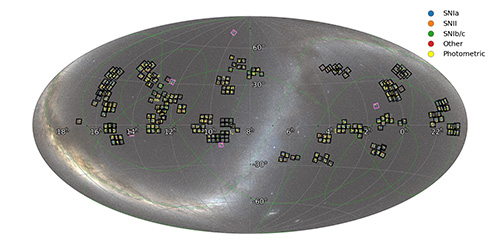Campus News
Young Supernova Experiment releases first set of transient survey data
UC Santa Cruz astronomers organized the survey, which has discovered thousands of cosmic explosions and other transient events of interest to astronomers and astrophysicists.


The Young Supernova Experiment (YSE) began surveying the night sky in 2019, using the Pan-STARSS1 telescope in Hawaii to detect cosmic explosions and other transient astrophysical events shortly after they occur. Now, the first YSE data release is available to the entire astronomy research community.
“This survey is a discovery portal,” said Ryan Foley, assistant professor of astronomy and astrophysics at UC Santa Cruz, who led the organization of the YSE survey project. “We are finding thousands of interesting objects, which we can then follow and study with additional observations to understand what we’re seeing.”
While most objects in the night sky remain the same night after night, transient or “time-domain” astrophysics focuses on dynamic sources that change on human time scales. These transient sources are typically highly energetic astrophysical events—such as supernovae, tidal disruption events, and kilonovae—which evolve quickly, rising to a maximum brightness and then fading away over days to months.
The Young Supernova Experiment surveys an area of the sky equivalent to 6,000 times the full moon (4% of the night sky) every three days and has discovered thousands of new cosmic explosions and other astrophysical transients, dozens of them just days or hours after explosion.
“We are effectively making movies of the night sky,” Foley said. “The sources we can detect this way are some of the most exciting things in the universe—the deaths of stars, the formation of black holes, and other extreme high-energy scenarios.”
The new YSE data release is the largest low-redshift multi-band data release of supernovae ever—slightly fewer than 2,000 objects—and is the first to use photometric classification and photometric redshifts extensively. This provides valuable precursor data for astronomers to study in advance of the Vera C. Rubin Observatory Legacy Survey of Space and Time (LSST), which is expected to transform time-domain astrophysics by discovering orders of magnitude more transient events per year.
“This is a sneak peak of what the Rubin Observatory will give us, so we can use it to train algorithms and prepare for when that massive data stream comes,” Foley said.
Taken with the Pan-STARRS1 telescope at the Haleakalāa Observatory in Hawaiʻi, the YSE data is transferred to the University of Hawaii’s Information Technology Center for initial processing and calibration. Image data was stored, processed, and analyzed on computing systems at UC Santa Cruz, the National Center for Supercomputing Applications (NCSA) at the University of Illinois, and the Dark Cosmology Centre (DARK) at the Niels Bohr Institute at the University of Copenhagen.
Gautham Narayan, deputy director of the NCSA’s Center for AstroPhysical Surveys (CAPS), is leading the cosmological analysis for the data sample, and former CAPS graduate fellow Patrick Aleo is lead author of a paper on the data release, “The Young Supernova Experiment Data Release 1 (YSE DR1): Light Curves and Photometric Classification of 1975 Supernovae.”
“The data release is an important milestone for supernova science and a testament to the hard work of astronomers scattered across the world at all career stages—from undergraduate students to professors, pipeline scientists, observers and more,” Aleo said. “With further study, it will provide insights into the origin of the supernovae, the properties of their progenitor stars, and the structure of their host galaxies. I am excited to see it used as a reference point for future surveys and the research that the community produces with this dataset.”
“Much of the time-domain universe is uncharted,” Narayan said. “We still do not know the progenitor systems of many of the most common classes of transients, such as type Ia supernovae, while still using these sources to try and understand the expansion history of our universe. There are many kinds of transients that are theoretically predicted but have never been seen at all.”
Narayan added, “With high-redshift experiments such as the Vera C. Rubin Observatory and the Nancy Grace Roman Space Telescope about to begin operations, we saw an opportunity to establish our Young Supernova Experiment to be a low-redshift anchor. We can probe time scales that these newer experiments cannot and find lots of transients in the nearby universe to compare to their samples in the distant universe.”
Foley’s team has published several papers based on follow-up observations of transients initially detected by YSE. But he said there is much more work to be done with the data now being released. “The real power here is in the sample sizes, not just the one-in-a-thousand events,” he said. “When you have a big sample of one kind of supernova you can really start to understand that population and its diversity, and that’s something we have not fully taken advantage of yet.”
YSE is a collaboration between UC Santa Cruz, the DARK Cosmology Centre (University of Copenhagen), the University of Illinois, and other partner institutions. In addition to Foley, other UCSC astronomers involved in the project, all coauthors of the paper, include Professor Enrico Ramirez-Ruiz, postdoctoral scholars María José Bustamante Rosell, Phil Macias, Peter McGill, and Kirsty Taggart, and graduate students David Coulter, Kyle Davis, César Rojas-Bravo, Sierra Dodd, and Ricardo Yarza.